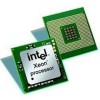Intel X5472 Specification Update - Page 15
Identification Information, Component Identification via Programming Interface
 |
UPC - 735858201551
View all Intel X5472 manuals
Add to My Manuals
Save this manual to your list of manuals |
Page 15 highlights
Identification Information Component Identification via Programming Interface The Intel® Xeon® Processor 5400 Series stepping can be identified by the following register contents: Reserved Extended Family1 Extended Model2 Reserved Processor Type3 Family Code4 Model Number5 Stepping ID6 31:28 27:20 19:16 15:14 13:12 11:8 7:4 3:0 0000000b 0001b 00b 0110b 0111b XXXXb When EAX is initialized to a value of 1, the CPUID instruction returns the Extended Family, Extended Model, Type, Family, Model and Stepping value in the EAX register. Note that the EDX processor signature value after reset is equivalent to the processor signature output value in the EAX register. Notes: 1. The Extended Family, bits [27:20] are used in conjunction with the Family Code, specified in bits [11:8], to indicate whether the processor belongs to the Intel386, Intel486, Pentium, Pentium Pro, Pentium 4, or Intel® Core™ processor family. 2. The Extended Model, bits [19:16] in conjunction with the Model Number, specified in bits [7:4], are used to identify the model of the processor within the processor's family. 3. The Processor Type, specified in bits [13:12] indicates whether the processor is an original OEM processor, an OverDrive processor, or a dual processor (capable of being used in a dual processor system). 4. The Family Code corresponds to bits [11:8] of the EDX register after RESET, bits [11:8] of the EAX register after the CPUID instruction is executed with a 1 in the EAX register, and the generation field of the Device ID register accessible through Boundary Scan. 5. The Model Number corresponds to bits [7:4] of the EDX register after RESET, bits [7:4] of the EAX register after the CPUID instruction is executed with a 1 in the EAX register, and the model field of the Device ID register accessible through Boundary Scan. 6. The Stepping ID in bits [3:0] indicates the revision number of that model. See Table 2 for the processor stepping ID number in the CPUID information. Cache and TLB descriptor parameters are provided in the EAX, EBX, ECX and EDX registers after the CPUID instruction is executed with a 2 in the EAX register. 15 Intel® Xeon® Processor 5400 Series Specification Update















